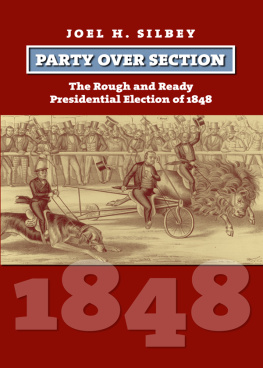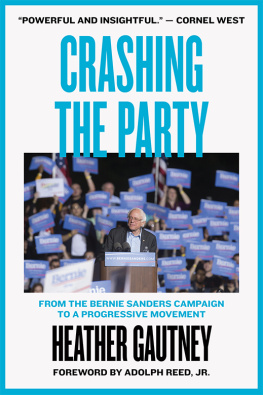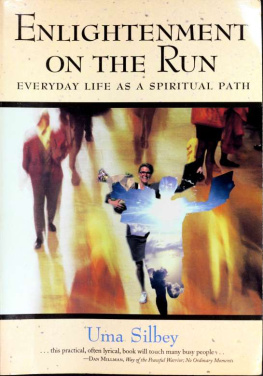All photographs are courtesy of the Library of Congress.
2009 by the University Press of Kansas
All rights reserved
Published by the University Press of Kansas (Lawrence, Kansas 66045), which was organized by the Kansas Board of Regents and is operated and funded by Emporia State University, Fort Hays State University, Kansas State University, Pittsburg State University, the University of Kansas, and Wichita State University
Library of Congress Cataloging-in-Publication Data
Silbey, Joel H.
Party over section : the rough and ready presidential election of 1848 / Joel H. Silbey.
p. cm.(American presidential elections) Includes bibliographical references and index.
ISBN 978-0-7006-1640-4 (cloth : alk. paper)
ISBN 978-0-7006-2538-3 (ebook)
1. PresidentsUnited StatesElection1848. 2. Taylor, Zachary, 17841850. 3. Van Buren, Martin, 17821862. 4. Cass, Lewis, 17821866. 5. United StatesPolitics and government18451849. I. Title.
E420.S55 2009
324.973dc222008044078
British Library Cataloguing-in-Publication Data is available.
Printed in the United States of America
10 9 8 7 6 5 4 3 2 1
The paper used in this publication is recycled and contains 30 percent postconsumer waste. It is acid free and meets the minimum requirements of the American National Standard for Permanence of Paper for Printed Library Materials z39.48-1992.
To Madeline S. R. Silbey and Her Fellow
Conspirators on the Main Line
EDITORS FOREWORD
The law of unintended consequences is nowhere more evident than in the political history of the United States in the years after 1845. Manifest Destiny, as the historian Allan Nevins once noted, yielded bitter fruit. Yet few Americans in the middle 1840s anticipated such a harvest. Elected on a platform calling for the reannexation of Texas and the reoccupation of Oregon, James K. Polk of Tennessee, the Democratic dark horse, assumed office in 1845 with a clear agenda. During his single term, he proved remarkably effective in carrying that agenda out. Indeed, by the middle of Polks term, the United States had extended its territorial domain to the Pacific.
Issues hitherto suppressed now demanded attention and resolution. How were the new territories to be organized and governed? By what process ought they to qualify for admission to the Union? Most important, should these territories be open to settlement by all Americans, and, if so, could those Americans take their property, which included their slaves, with them?
The matter of slaverys boundaries had been laid to rest in 1820. The Missouri Compromise had fixed the territorial limits of slavery within the area of the Louisiana Purchase. Though that act appeared successfully to remove slavery from the political arena, in fact, a small but vocal antislavery movement continued to agitate for the radical step of abolition. Abolitionists were few in number, however, and effectively isolated on the periphery of national politics by the so-called Gag Rule, a congressional decision automatically to table their petitions.
The acquisition of new territory changed all that. For the first time, Americans who harbored genuine reservations about the peculiar institution but were unwilling to interfere with slavery where it existed discovered a new and compelling intermediate position. Congressman David Wilmot, a Democrat from Pennsylvania, introduced a proviso to that effect in 1846. It passed the House, where nonslaveholding states were in the majority, but failed in the Senate, where North and South were evenly balanced. Almost immediately, all the other issues that seemed so pressingbanks, tariffs, internal improvementsand that had been the basis for the political party system pitting Democrats against Whigs seemed to recede into the background. Free Soil, the belief that slavery should not be permitted to expand beyond its 1820 boundaries, quickly became part of the political vocabulary.
These momentous events set the stage for the tumultuous election of 1848, a story well told by a master historian. Joel Silbey notes the stresses placed upon the party system by the emerging issue of slavery but argues that party loyalty prevailed over sectional allegiance. We follow a three-way contest for the presidency that pits a slaveholding military hero against a Michigan senator and a former president from New York. Zachary Taylor prevails over both Lewis Cass and Martin Van Buren. Though unsuccessful, and perhaps a sacrifice on the altar of party, it is Van Burens candidacy on the ticket of a new Free Soil movement that portends what will ultimately put the future of the Union at stake.
Meantime, Whigs and Democrats both are attracted by the Free Soil appeal even as party loyalists try, for the most part successfully, to hold their members in line. A new cast of characters, many of whom will assume major roles on the political stage in years to come, populates the narrative: Abraham Lincoln and Stephen A. Douglas, William Seward and Salmon P. Chase, Charles Francis Adams and William Lowndes Yancey, all have parts during this contest.
Slaverys defenders, fearing the tyranny of a sectional majority, take comfort in Taylors victory. Slaverys opponents, augmented in numbers and more diverse in position, fear the consequences of defeat. Yet the issue remains unsettled, and the territorial question will continue to vex the country until, finally, separation comes in 1861.
Such omniscience, of course, was not present in 1848, which imparts to the narrative an element of genuine tragedy even as, from the perspective of the participants, party still seemed an effective antidote to the centrifugal force of the slavery issue. The route to civil war, as Professor Silbey reminds us, was neither direct nor necessarily inevitable. There can be no doubt, however, that it reached a significant crossroads, and was at least temporarily arrested, in a critical election in that momentous year.
AUTHORS PREFACE
For much of the western world, 1848 was a year of severe political challenge, popular unrest, violent uprisings against the status quo, and a number of successful revolutions. From London to Paris to Vienna empires shook, several monarchies collapsed under the assault against them, and all over Europe, liberal reform ideas and democratic governments replaced what previously had been the dominant reactionary political ethos of the continent. Across the Atlantic, the United States escaped the violence and the overthrow of conservative governing institutions and elites that occurred elsewhere that year. But it, too, experienced an attack on the usual understandings and practices of its political world. Specifically, although no one took to the streets (except in campaign rallies and parades), 1848 was a year of political challenge that vigorously sought to limit the reach of what many considered to be a decadent social and economic system in the nations southern states based on human slavery. For the first time, an organized political program calling for the containment of slavery within then-established boundaries took a primarily electoral focus in the platform of the Free Soil Party in an attempt to win the presidency and other offices that year. More focused and coherent than earlier advocates of limiting the institution had been, the Free Soilers verbally assaulted the region that practiced slavery along with a national political system in which most of the participants were indifferent or hostile to their concerns and preferred to concentrate their attention on other matters.










